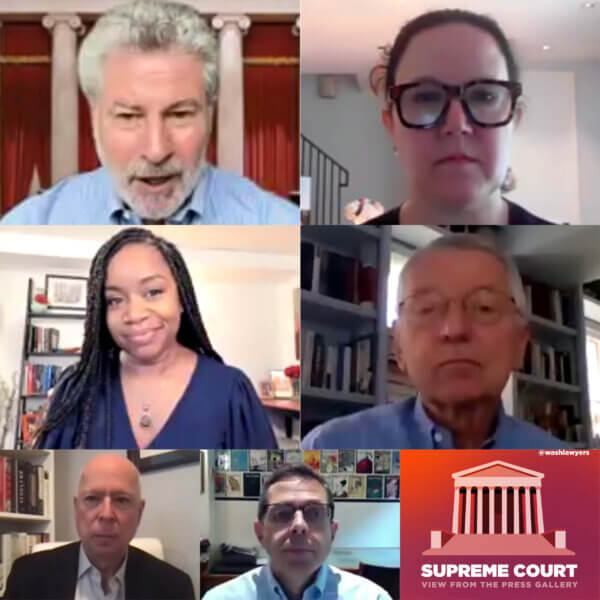
Supreme Court: View from the Press Gallery Recap
By Kelly Panlaqui
On Thursday, July 7, lawyers, law students, and legal professionals around the country attended our 34th annual Supreme Court: View from the Press Gallery event. Our panel of journalists who cover the Court talked about the unusual recently concluded term. Art Spitzer, Senior Counsel at ACLU-DC, moderated the panel with these distinguished Supreme Court journalists:
- Amy Howe, Author of the Blog “Howe on the Court” and Independent Contractor and Reporter for SCOTUSBlog
- Adam Liptak, New York Times Supreme Court Reporter and Writer of the Legal Developments Column “Sidebar”
- David Savage, Los Angeles Times Legal Issues and Supreme Court Reporter
- Mark Sherman, Associated Press Supreme Court Reporter
- Kimberly Atkins Stohr, Senior Opinion Writer and Columnist at Boston Globe and the Emancipator Publication
The discussion started off with everyone agreeing that it was a momentous term. Art Spitzer then set the stage for the discussion by asking the panelists what was most notable or surprising for them about the term. David Savage, who has been covering the Court the longest, started off by elaborating on the summer of 1986 when William Rehnquist became Chief Justice. Justice Anton Scalia also joined the court that term and there were already talks about how abortion rights, affirmative action, and the separation of church and state were in danger. Justice Rehnquist was not in favor of the separation of church and state and both Justice Rehnquist and Justice Scalia voted to uphold a law in Louisiana that required equal time for creationism in schools. David observed that the conservative legal agenda has remained largely unchanged for the past 30 years and what was most notable for him was that suddenly all the big cases regarding abortion, gun regulation, and religion were being decided in favor of the conservative agenda. “It was definitely notable but not surprising,” said David.
Mark Sherman was surprised at how Chief Justice Roberts could not slow down the conservative agenda. Kimberly Atkins Stohr stated that although there have been ideological differences between the Justices, in the past, that hasn’t translated to political outcomes for cases before the Court. However, the public could not now be faulted for thinking the Court is delivering political results with the decisions they made this term. Kimberly also noted the increased use of the emergency docket throughout the term and how the Court has become a “different animal” than what it used to be. Adam Liptak discussed how historically one couldn’t tell how each Justice was going to vote. An example would be how Justice Kennedy, despite being appointed by a Republican President and mostly right-leaning, would make unexpected decisions and didn’t always vote with the conservatives on certain issues. Adam contrasted that with what appears to be happening in the Court now. He posited that “Trump cracked the code” with his nominations in that he was able to find three Justices who would consistently side with the conservative agenda. Amy Howe talked about how she had a sense of watching history in the making both with the decisions and the return of the Justices to the building.
Transitioning from Amy’s last statement with the mention of the pandemic, Art moved to the second topic of how the pandemic influenced this term and each panelist’s ability to cover the court. Amy started off by saying how she tried to go to as many in-person arguments as she could including cases that she wasn’t covering. She would use every opportunity to see the dynamics between the Justices. Because only the press was allowed in the courtroom, the mask mandate and social distancing policies allowed them to be spread out beyond the press section and see the proceedings from a different angle. Additionally, the Justices were not releasing opinions from the bench, which was a strict departure from previous practices. Our panelists speculated about how this change in procedure affected the Justices and how it was more difficult to gauge the dynamics between the Justices. Mark talked about the sense of drama that only happens once or a couple of times each term. This would usually happen when the majority opinion and then the dissenting opinion was delivered from the bench, which would often result in some insight into the deliberations in the case. Mark said that “due to the pandemic, this made the release of decisions bloodless.”
The discussion then moved to how covering the Supreme Court differs from covering any other institution. Mark elaborated on the fact that with the leak of the Roe v Wade draft opinion and the increased use of the emergency docket, the Court is slowly becoming like the other institutions he covered. Kimberly agreed and added that out of the different departments she covered which included the White House, Congress, and the Supreme Court, she enjoyed going to the Court because it gave her a sense of a “normal day feeling.” She said that in the Court there’s assigned seating, a designated start time, and there’s a guaranteed call to action in the courtroom. All our panelists agreed, that the practices of the Court this term were different than at any other point in its history, which may be contributing to the loss of confidence by the general public in the Court and the sense the political agendas are being moved forward through the Court.
Art then asked about the Dobbs v Jackson case, specifically the Court waiting to release “big decisions” until late in the term. In the Dobbs case, Justice Alito had circulated the draft opinion back in early February but the decision wasn’t released until June. The panel explored whether there was any value to waiting. Adam answered this by stating that for bigger cases, the wait is valuable because the decisions will most likely be included in future law textbooks and both sides will look at each other’s footnotes. The Justices also prefer releasing more controversial decisions in June because if there is any acrimony between the Justices, they have the summer to take a break from one another. David made a note that late releases are normal, but leaks are abnormal.
With that observation, the discussion moved to the hottest topic right now which was the leak of the draft opinion for Roe v Wade. Many of the panelists were shocked to hear the news when it got out and Kimberly spoke about how she was in the car with her husband (a fellow Supreme Court journalist) when their supervisors started spamming their phones with the news. She said, “I had to keep my husband from crashing the car and read the news to him on the way home. Once we got home, we went to our separate offices, and went to work immediately.” Many of the panelists agreed that they never thought a leak could happen and that the institution has now changed forever. It created a tense atmosphere afterward as many felt like they had to look over their shoulder most of the time. It changed the way people inside the court viewed each other and created a political climate around the Court that previously did not exist.
Adam elaborated on the importance of the breach of trust. Justice Thomas was quoted as saying, “It’s like kind of an infidelity that you can explain it, but you can’t undo it.” The panelists agreed that the Justices were like a family that no longer felt like a family, and predicted that it may take some real time to heal from all of this. Mark said it was interesting to see that Justice Thomas was so hurt by it as he was in the majority on a lot of the big cases this term, and Mark thought Justice Thomas would have been more positive despite the leak. He also elaborated on the somber feeling that was visible among the Justices when coming from behind the curtain. He said that they usually exchange a joke or two before returning to the bench, but that joyful behavior was not evident after the leak.
Art then asked if the journalists knew any updates regarding the investigation and if the U.S. Marshals had been searching cell phones or had identified people of interest. But none of the journalists knew the answer or could shed any light on the active investigation. Art then asked about the law clerks and if they were afraid of talking to each other. Mark reminded us that the clerks had turned over, and there is now a new group of clerks. Art wondered if the system for sharing draft opinions would change or if any other steps were being taken to ensure no further leaks.
The discussion then shifted to the Justices’ personalities and specifically if the journalists now have a better sense of Justice Barrett. David responded with no because she wrote very little on the big cases but still showed that she is intelligent and can write well. Kimberly agreed and added that she was the only woman who agreed to overturn Roe v Wade while not writing in the case. Despite her saying that she could think for herself and form her own opinions, Kimberly was disappointed to not see that side of her as much this term. Art then asked if they had thoughts regarding the Justices’ homes being picketed. Kimberly responded that she wasn’t sure if it was effective, but did predict a First Amendment challenge regarding the public being on the Justices’ private properties instead of for example the street across from a federal building.
To conclude the panel discussion, Art then shifted to the cases docketed for the next term which include affirmative action, college admissions, and the voting rights act. Specifically, Art solicited comments on Moore v Harper. This case concerns the independent state legislature doctrine. It questions whether state legislatures alone are empowered by the Constitution to regulate federal elections without oversight from state courts. Adam expanded on the fact that if we gave state legislatures power over elections it would allow them to do whatever they want, and the Supreme Court couldn’t interfere. It would technically violate the constitution and is a “recipe for mischief,” says Adam. With the consequences of the leak still unclear, and some big cases to be decided next term, the journalists are certainly watching to see what’s next.
Catch up on the conversation and share your thoughts on this term on social media using #SCOTUSpress!
Kelly Panlaqui is our 2022 Summer Intern.






